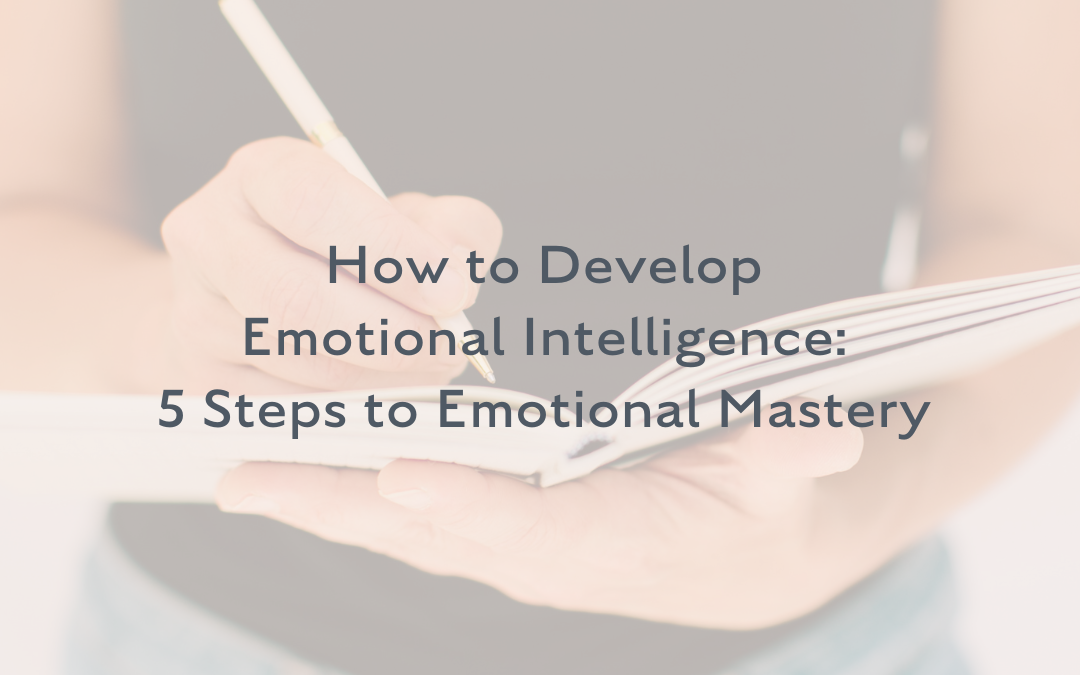
How to Use EFT Tapping for Stress and Anxiety
How to Use EFT Tapping for Stress and Anxiety
Table of Contents

Hey there! I’m Brenda Terry.
I’m a Mindset and Business Mentor and an NLP master coach trainer. I help you train your brain for success, break through mental and emotional blocks, reclaim your personal power, and take results-based action to finally get what you want in business and life.
Table of Contents
EFT Tapping: Empower Yourself Against Stress and Anxiety
Are you feeling overwhelmed by stress and anxiety? You’re not alone. In today’s fast-paced world, it’s easy to get caught up in the daily grind and feel like we’re constantly juggling a million things at once.
It can be really overwhelming to try to take control of our thoughts, especially when it feels like so much is out of our control.
But these moments of stress and anxiety aren’t just mental burdens. They can affect our health, our happiness, and even our ability to achieve our goals and manifest our deepest dreams.
And it doesn’t have to stay that way because you can learn to quickly manage your thoughts and feelings in a way that really works for you and that supports you in effectively reducing stress and anxiety for good.
In this blog post, you’ll learn the impact of stress and anxiety on our minds and bodies and how EFT Tapping can be a simple yet powerful tool to help reduce stress and anxiety, empowering you to relieve stress quickly and regain control of your daily life.
Let’s dive in!

What is Stress?
First, let’s understand what stress and anxiety really are. Stress is the body’s natural response to a perceived threat or challenge. It can be triggered by external factors such as work demands, financial pressures, or relationship struggles, but it can also stem from internal sources like our own negative thoughts and beliefs. When we experience stress, our body releases hormones like adrenaline and cortisol, preparing us to take action against the perceived danger.
Stressors can be a one-time occurrence, a short-term episode, or a recurring circumstance in our lives. Understanding how stress impacts our brain and body is crucial for managing it effectively and maintaining overall health and well-being.
Understanding Anxiety
Anxiety is a feeling of worry, fear, or unease about an uncertain outcome. While it’s normal to feel anxious from time to time, excessive worrying or constant feelings of anxiety can interfere with daily life and lead to physical symptoms such as tense muscles, difficulty breathing, and digestive problems.
Anxiety can be triggered by various stressors, such as work-related deadlines, financial struggles, relationship problems, or even traumatic events. When we experience anxiety, our brain activates the fight-or-flight response, which is a natural survival mechanism. This response prepares our body to either confront the threat or flee from it.
The Dangers of Chronic Stress
While a certain level of stress can be beneficial in motivating us to accomplish tasks or meet challenges, prolonged or chronic stress can have negative effects on our physical and mental well-being. The repeated activation of the stress response inflicts damage on the body, contributing to various health issues such as high blood pressure, heart disease, and a weakened immune system.
In addition to physical health problems, chronic stress can also lead to the development of anxiety disorders. When our body is constantly in a state of fight-or-flight, it becomes difficult for us to relax and calm down. This ongoing feeling of tension and unease can eventually develop into an anxiety disorder.
When Stress Becomes a Pattern
Our bodies and minds become accustomed to feeling stressed and anxious when stress becomes habitual, making those feelings our default state. Essentially, we can develop a habit of generally feeling stressed and anxious no matter what’s going on. We might find ourselves constantly worrying, feeling tense, or struggling to relax, even when there’s no apparent reason.
This constant state of stress can put a strain on our mental health and lead to the development of anxiety disorders such as generalized anxiety disorder, panic disorder, or social anxiety disorder.
Moreover, chronic stress can also negatively impact our relationships. When we are stressed and anxious, we may become irritable, impatient, and easily frustrated. This can cause conflicts with those around us, leading to strained relationships with loved ones, friends, and colleagues.
Understanding, Recognizing, and Addressing the Impact of Chronic Stress
Chronic stress is a serious condition that should not be taken lightly. It is important to recognize the signs and symptoms of chronic stress in order to manage it effectively. Some common symptoms include irritability, fatigue, difficulty concentrating, and changes in appetite or sleep patterns.
Making lifestyle changes, such as incorporating regular exercise, practicing relaxation techniques like meditation or yoga, and maintaining a healthy diet, can all help to reduce the effects of chronic stress. Additionally, seeking support from friends and family or talking to a therapist can also be beneficial.
In addition to these lifestyle changes, it is also important to address any underlying issues that may be causing chronic stress. This could include making changes in your work environment or learning new coping mechanisms for dealing with difficult situations.

Benefits of Managing Stress
The benefits of managing stress go beyond feeling more relaxed; they extend to your physical and mental health practice, cognitive abilities, and overall quality of life.
Here are 7 benefits of managing stress effectively
1. Improved Health
Chronic stress has been linked to a variety of health issues, including high blood pressure, heart disease, and obesity. By managing your stress levels, you can reduce your risk of developing these conditions and improve your overall health.
2. Better Sleep
Stress can often lead to trouble sleeping, which can further exacerbate the effects of stress. By learning how to manage your stress effectively, you can improve your sleep quality and feel more rested and rejuvenated.
3. Increased Productivity
When we are stressed, it can be challenging to focus and stay productive. By managing our stress levels, we can reduce distractions and increase our ability to concentrate, leading to increased productivity in both our personal and professional lives.
4. Enhanced Mental Clarity
Chronic stress has been shown to impact cognitive function, including memory and decision-making abilities. By managing stress levels, we can improve mental clarity and make better decisions.
5. Pain Reduction
Stress has been linked to various physical ailments, including headaches, muscle tension, and gastrointestinal issues. By managing stress, we can alleviate these symptoms and reduce the likelihood of developing chronic pain conditions.
6. Improved Relationships
Stress can put a strain on our relationships with friends, family, and coworkers. By effectively managing stress, we can communicate better and be more patient and understanding with those around us.
7. Increased Happiness
Chronic stress can lead to feelings of anxiety and depression. Through effective stress management techniques such as exercise, relaxation techniques, and self-care activities, we can improve our overall well-being and increase feelings of happiness.
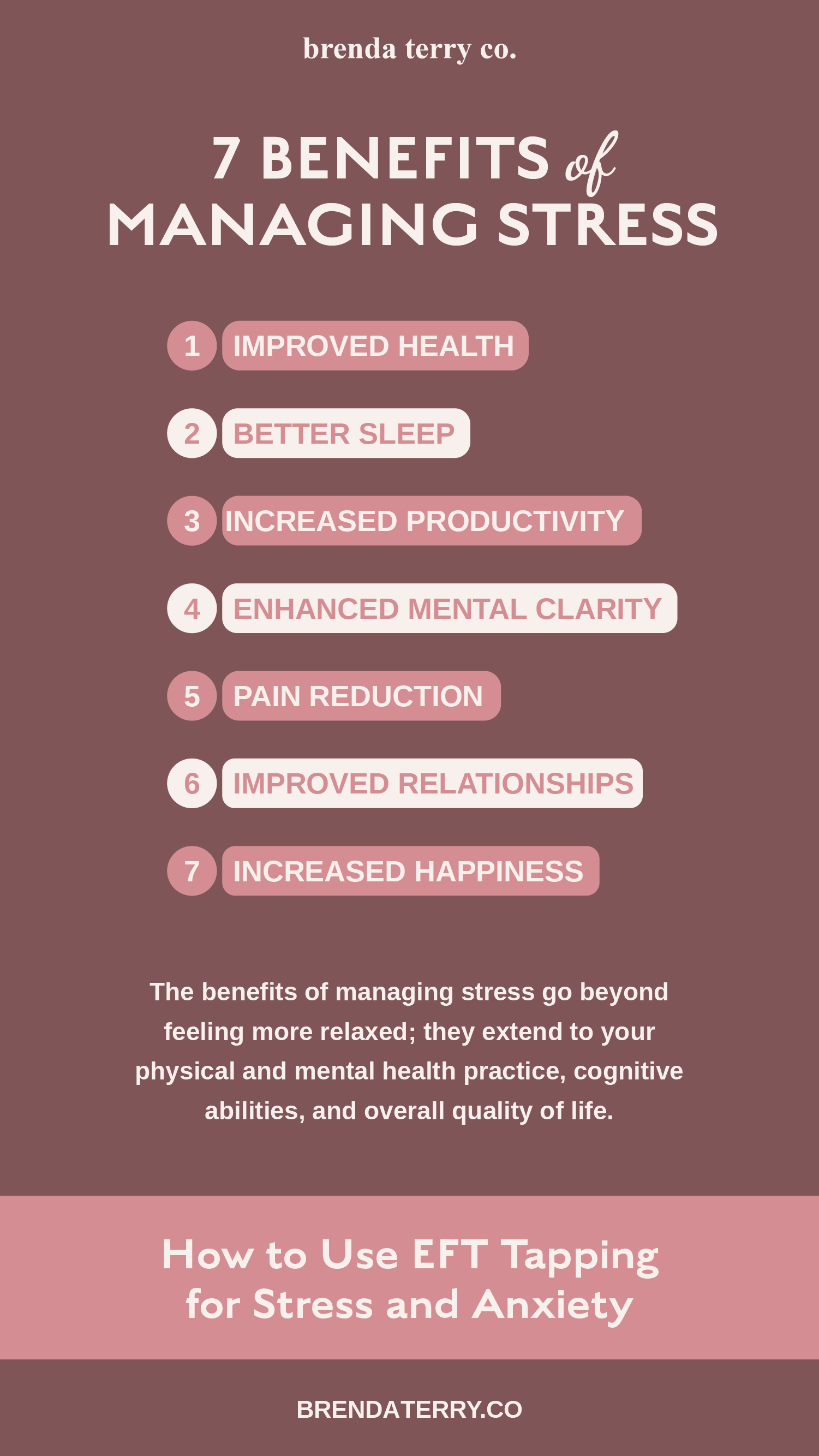
EFT Tapping for Stress and Anxiety Management
One effective technique for managing stress and anxiety is EFT tapping. EFT has been found to be helpful in reducing stress, anxiety, and other negative emotions. It works by balancing the body’s energy system, allowing us to release negative emotions and promote a sense of calmness and relaxation.
What is EFT Tapping
EFT, short for Emotional Freedom Technique, merges ancient Chinese acupressure, contemporary psychology, and the intricate interplay between mind and body. This technique involves tapping on specific points of the body while focusing on the stress or anxiety we’re experiencing.
Emotional Freedom Technique (EFT) is a form of energy psychology that addresses many emotional, physical, and mental diseases and psychological issues. EFT has been proven to alleviate symptoms related to anxiety, phobias, depressive symptoms, trauma, and other mental disorders and psychological problems.
Emotional Freedom Technique is based on acupuncture and traditional Chinese medicine principles, utilizing tapping instead of needles to stimulate the body’s energy pathways. EFT works by tapping on “EFT tapping points” on the body to release emotional stress, negative thoughts, and physical symptoms.
Emotional Freedom Technique is simple, noninvasive, and easy to learn. Its proven effectiveness in managing various emotional and physical issues makes it accessible to anyone seeking a natural stress reliever.
At its core, EFT can be described as a relaxation technique, a stress-management tool and an emotional version of acupuncture.
Emotional Freedom Technique has been found to be particularly effective in treating anxiety disorders. Research has shown that regular EFT sessions can significantly reduce levels of anxiety, phobias, depressive symptoms, trauma, and other mental health conditions. This is because by using EFT, we can process negative emotions and reframe thoughts in a more positive way.
Emotional Freedom Technique and the Mind-Body Connection
The foundation of EFT lies in recognizing the intrinsic connection between emotions and physical sensations and how they can influence each other. Through a blend of cognitive restructuring and tapping on meridian points, EFT tappings can release stress stored within our central nervous system (CNS) while releasing negative thoughts and emotions.
Practicing EFT entails tapping specific acupressure or acupuncture points on the body while focusing on negative emotions, limiting beliefs, or physical discomfort. Stimulating particular points in the body sends a calming signal to the brain, effectively tempering the stress response and promoting overall well-being.
This symbiotic relationship between the effects of EFT and the mind-body connection underscores the need for healthcare professionals to adopt a holistic approach to health. By concurrently addressing the physical and emotional realms, we can have improved health while enhancing happiness, tranquility, and vitality.

How Does EFT Tapping Work?
Think of stress or tension as interference with your body’s natural flow of energy—similar to mountains disrupting cell reception.
According to acupuncture principles, energy moves through meridians, and blockages in this flow lead to physical pain and emotional issues. EFT tapping works to eliminate these blockages.
The tapping technique serves as both therapy and a pattern interrupt, which is incredibly powerful.
With repetition, tapping becomes ingrained in your brain’s stress response. So, when stress or anxiety arises, you no longer spiral into a cycle of negative thoughts and emotions. Instead, a quick 3-minute tapping session becomes your go-to solution for stress. Once you do this enough, your natural response will be to manage stress quickly, which will effectively stop the stress cycle.
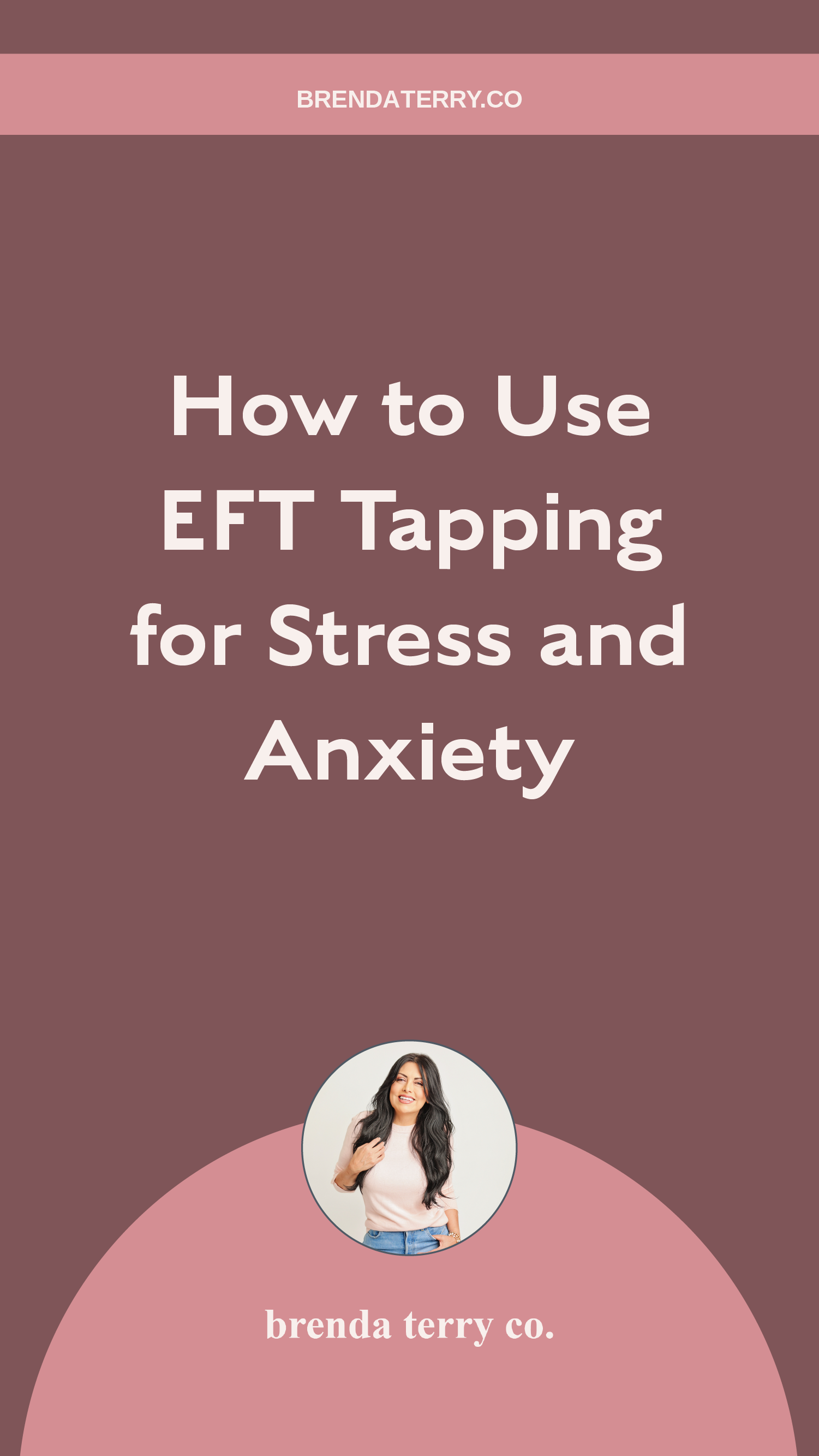
Activating the Negative with Emotional Freedom Techniques
A crucial component of EFT is activating the negative thoughts and feelings that are causing you distress. Although this may seem counterintuitive, it has everything to do with how our brains process emotions.
You see, when we suppress or ignore our negative emotions, they don’t magically disappear. Instead, they linger in our bodies, causing tension and unease. Eventually, this buildup can contribute to physical and mental health challenges.
The essence of EFT revolves around delving into a problem, trauma, or negative emotion. Through targeted tapping on specific points, EFT effectively collapses the emotional and physical symptomology of the issue, which helps us restore balance to our bodies and minds.
The Theory Behind Activating the Negative with EFT Tapping Basics:
Delving into the problem or negative emotions is crucial in the EFT process. By acknowledging and activating these emotions, we can effectively release them from our minds and bodies.
The idea behind activating the negative is that by bringing up the emotions or thoughts associated with a problem, we can address and release them effectively. It’s like shining a light on a dark area – we can only see what needs to be fixed when we acknowledge it.
Prioritizing negatives allows us to truly heal and move forward.
Attempting to tap into positivity without addressing the underlying negatives can impede progress and even worsen the problem. It’s like dressing a wound without cleaning it first; it may look better on the surface, but the underlying issue will persist and may even worsen.
During an EFT for stress tapping session, activating these negative thoughts or emotions is pivotal. Not only does it acknowledge their presence, but it also initiates the process of processing and neutralizing them. This allows for a deeper level of healing and can help to release any underlying stress or tension that may be causing physical or emotional discomfort.
EFT Tapping to Reduce Stress and Anxiety
Tapping is a remarkable tool for managing stress and anxiety because it requires no special equipment, complicated instructions, or financial investment.
You can practice tapping anywhere, anytime, making it easy to incorporate into your daily routine. All you need is just a few minutes and your fingertips.
Regular tapping can gradually reduce stress and anxiety levels over time, helping you maintain control of your emotions in challenging situations.
Consistent practice of EFT reduces cortisol levels, the hormone associated with stress. It also regulates resting heart rate, another indicator of stress.
Tapping also interrupts habituated stress patterns and helps reprogram our response to stress and anxiety. Instead of succumbing to worry or fear, we can train our minds to respond calmly and clearly.
Stress doesn’t have to control your life—EFT tapping techniques empower you to take charge of your well-being.
How to Relieve Stress Quickly and in the Long Run with EFT
EFT provides short-term comfort and opens the door to long-term change. By tapping for a few minutes daily, EFT can help us break free from deeply ingrained stress habits. With consistent practice, we can rewire our brains and create new, healthier responses to stressors.

EFT Tapping Points
The main tapping points in EFT are on the face and upper body. These points correspond to the body’s energy meridians, which are channels that transport energy throughout the body.
The following are the main tapping points in EFT:
- Side of the Hand (the “setup point”) Between the base of the little finger and the wrist
- Top of the Head: The crown of the head
- Between the Eyebrows: The center of the forehead, just above the nose
- Side of the Eye: The bony ridge at the outer corner of the eye
- Under the Eye: The bony ridge directly under the pupil of the eye
- Under the Nose: The crease between the nose and the upper lip
- Under the Lip: The crease between the bottom lip and the chin
- Sore Spot: Under the collarbone directly to the left or right of the sternum
- Under the Arm: One palm width under the armpit

How to Do EFT Tapping
The EFT Tapping Sequence
1. State the Problem
- This can be any specific emotional or physical problem or event.
2. Rate the Intensity
- “On a scale of 0 to 10, how intense is the feeling now?”
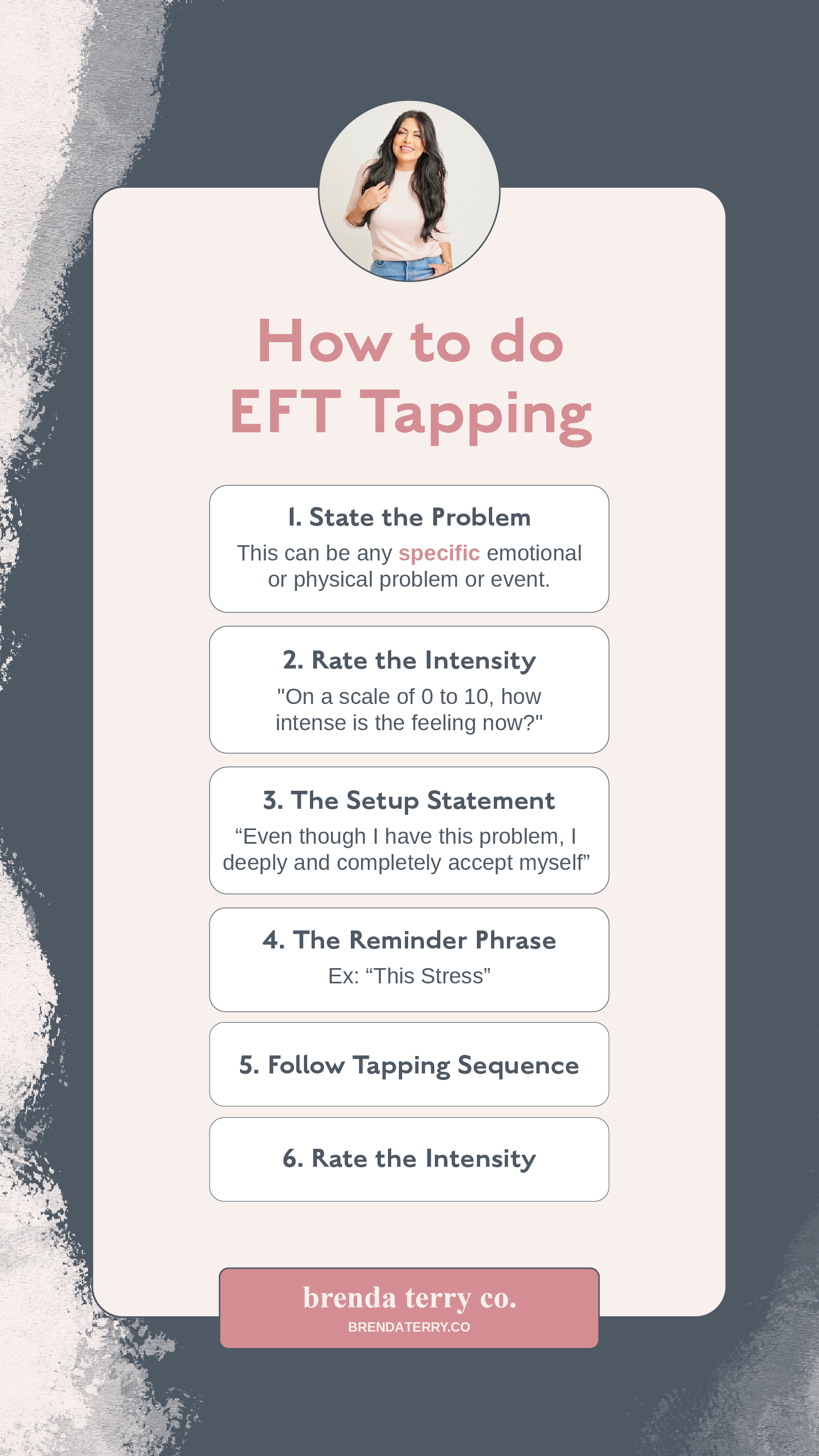
3. The Setup Statement
An elegant 3-part formula that frames the problem with exposure and self-acceptance is essential for effective emotional healing.
First Part – Acknowledgment
- “Even though…”
Second Part – The Problem
- “…I have this problem…”
Third Part – Cognitive Acceptance
- “…I deeply and completely love and accept myself…”
- Or “…I deeply and completely accept myself…”
4. Create a Reminder Phrase
Reminder Phrase Examples:
- “This stress and anxiety”
- “This stress”
- “This anxiety”
- “This worry”
- “This deadline”
5. Follow Tapping Sequence
- Tap on the Side of the Hand while repeating the Setup statement three times.
- Then, tap a minimum of seven times on the following acupressure points while repeating a reminder phrase
- Top of the head
- Between the eyebrows
- Side of the eye
- Under the eye
- Under the nose
- Under the lip (Chin)
- Sore Spot
- Under the arm
- Do 3-5 rounds
6. Rate the Intensity
- On a scale of 0 to 10, how intense is the feeling now?”
Repeat: If the intensity is still high, repeat the tapping sequence and setup statement until the intensity has reduced to a manageable level.
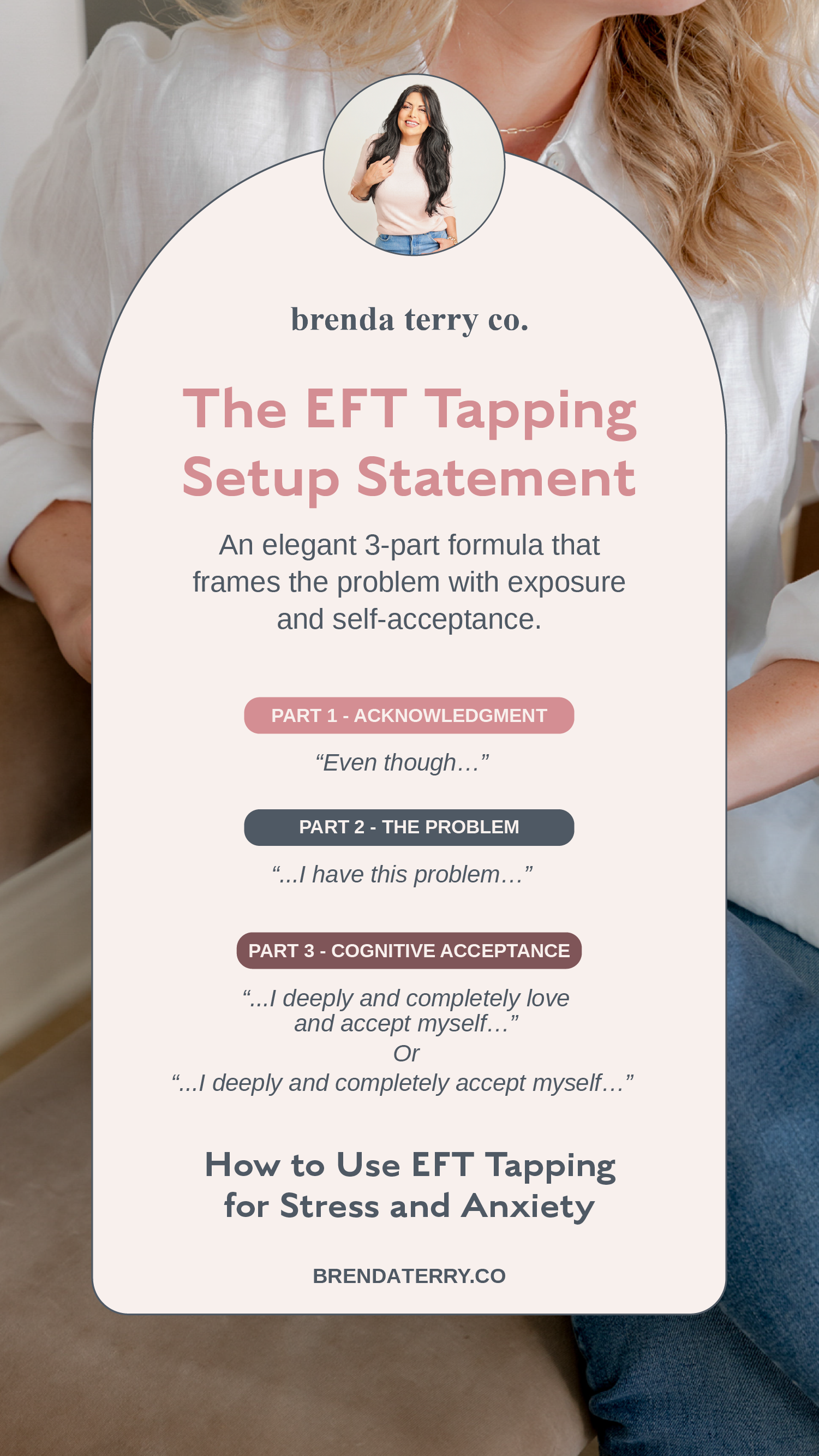
6 Practices for EFT Tapping Success
- Be specific
When you write, try to be as detailed as possible. Avoid being too broad or general; be clear about your exact issue or feeling. - Tap on Present-Moment Problems
It may be tempting to deal with all problems at once, but the best way to be successful is to focus on the feelings or issues you are facing right now. Taking on too much at a time can make the process less effective. - Routine Is Key
Make tapping a habit, even if it’s just once a week because consistency is important for results. It doesn’t have to be a long session, even 5 minutes can make a positive impact. - Mind the Gap: Keeping up with your sessions is essential, but giving yourself time to process and think after each is also important. It’s not a race, so let your breakthroughs and ideas come to you independently.
- Target Specific Challenges
EFT will yield the best results when you focus on specific issues or feelings instead of trying to fit them into broad explanations or names. When you are struggling with a certain emotion or problem, hone in on that and use EFT to address it directly. - Use Personalized Phrases
Using your own words to describe the problem or feelings you are addressing can make EFT even more effective. This allows for a deeper connection and understanding of the issue, leading to better results.

By proactively managing our emotions and tapping into the mind-body connection, you will pave the way for a brighter, more fulfilling life.
Remember, stress and anxiety may knock on our door, but with EFT Tapping as our trusted ally, you hold the key to unlocking calmness, clarity, and resilience.
Are you ready for powerful stress relief?
That’s exactly why I created The Ultimate Stress Relief Guide. With this guide, you’ll learn how to reclaim your calm, increase resilience, and stop stress in its tracks so you can take charge of your business and life.
With powerful tools, including NLP techniques, you’ll be able to prevent and eliminate stress, take charge of your emotions, and become truly unstoppable.
Table of Contents

Hey there!
I'm Brenda Terry
I'm a Mindset and Business Mentor and an NLP master coach trainer. I help you train your brain for success, break through mental and emotional blocks, reclaim your personal power, and take results-based action to finally get what you want in business and life.
This blog is where I share my insights, tips, and strategies for personal growth, mindset mastery, and business success. My goal is to empower you to reach your full potential and create a life of purpose, passion, and abundance.

Hey there!
I'm Brenda Terry
I'm a Mindset and Business Mentor and an NLP master coach trainer. I help you train your brain for success, break through mental and emotional blocks, reclaim your personal power, and take results-based action to finally get what you want in business and life.
This blog is where I share my insights, tips, and strategies for personal growth, mindset mastery, and business success. My goal is to empower you to reach your full potential and create a life of purpose, passion, and abundance.



